Ornaments - Photo gallery
Image database with photographs of ancient art and antiquities
Our image database provides photographs of ancient art and antiquities for press releases as well as for private use. All artefacts sold in our gallery are documented through professional photographs. The resulting image library contains numerous ancient Egyptian, Greek and Roman antiquities as well as ancient coins. The time span from Stone Age, over Bronze Age and Classical Antiquity until Late Antiquity is covered.The photo gallery aims at providing a vast visual archive equipped with filters and search tools. You are most welcome to search the constantly growing number of artefacts in the image library. We are also happy to authorize hyperlinks from your webpage / forum to the objects depicted in our gallery. For this purpose, please send us a short notification prior to placing a hyperlink. For almost every object high definition photographs are available and can be provided e.g. to document your collection or for scientific papers or popular science articles. If you are interested in using pictures for publications, print media or other purposes, please contact us and we will be happy to assist you.
-
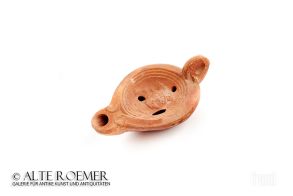 Roman imperial oil lamp with Hermes
Roman imperial oil lamp with HermesFrom the German collection Becker, in this for 3 generations.
Price: on request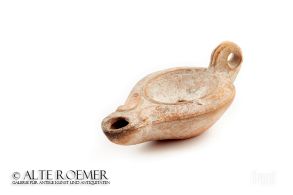 Roman oil lamp found in the 1890s in Cologne
Roman oil lamp found in the 1890s in CologneFound in the Mauritiussteinweg street during construction works. Since 1890s in the private Cologne collection O.
Price: on request Cowroid with magic spell
Cowroid with magic spellThe hieroglyphs of the anra type are to be interpreted as magical formula. From the Second Intermediate Period of ancient Egpyt. This scaraboid is described in the catalogue of Gautier-Vodoz.
Price: on request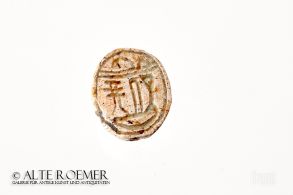 Cowroid with decorated body
Cowroid with decorated bodyThe cowroid has an interesting decoration across the upper surface. The lower surface is inscribed with hieroglyphs. This cowroid is discussed in the catalogue of Gautier-Vodoz.
Price: on request Bronze Age axe head
Bronze Age axe headVery well preserved axe head. Late Bronze Age, 10th to 9th cent. BC.
Price: on request Leaden sling bullet with inscriptions
Leaden sling bullet with inscriptionsAlmond shaped lead bullet of a slinger. It was part of the equipment of a Greek army from the late 5th to the 2nd century BC.
Price: on request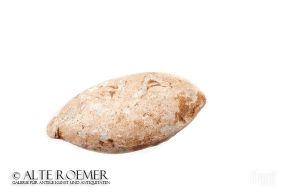 Leaden sling bullet with inscriptions
Leaden sling bullet with inscriptionsAlmond shaped lead bullet of a slinger. It was part of the equipment of a Greek army from the late 5th to the 2nd century BC.
Price: on request Massive roman oil lamp
Massive roman oil lampMade in North Africa in the late 3rd century AD. From an old collection
Price: on request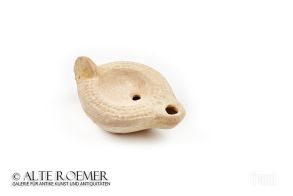
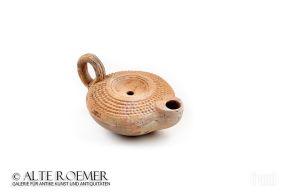 Roman oil lamp decorated with dots
Roman oil lamp decorated with dotsNicely preserved piece with heart-shaped nozzle.
Price: on request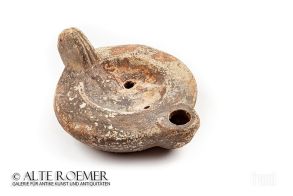
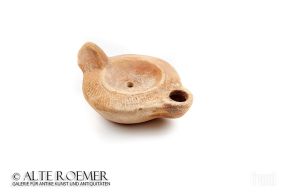 Roman oil lamp with heart-shaped nozzle
Roman oil lamp with heart-shaped nozzleNicely preserved oil lamp from the Roman Imperial era.
Price: on request Roman oil lamp with heart-shaped nozzle
Roman oil lamp with heart-shaped nozzleNicely preserved oil lamp from the Roman Imperial era.
Price: on request Roman oil lamp showing Sol-Helios
Roman oil lamp showing Sol-HeliosInteresting transition type to the so-called North African oil lamps. Nicely preserved, unusual piece.
Price: on request Roman oil lamp with head of a Taurus as handle
Roman oil lamp with head of a Taurus as handleRare type with plastic handle and large cross on base.
Price: on request Egyptian frog lamp from very old German collection
Egyptian frog lamp from very old German collectionThe frog lamps developed in Egypt close to Abydos. For the Egyptians, the frog symbolized birth and resurrection, this symbolism was also adapted by the early Christians. From the German collection Becker, in this for 3 generations.
Price: on request Impressive Roman imperial bronze oil lamp
Impressive Roman imperial bronze oil lampBeautiful patina, very well preserved. With large leaf-shaped handle. Dating to 1st - 2nd century AD.
Price: on request Pre-Dynastic pottery of Ancient Egypt
Pre-Dynastic pottery of Ancient EgyptThe simple vessel is made of coarse clay. It dates to the end of the 4th millenium BC and hence witnessed the beginning of the Ancient Egyptian civilization.
Price: on request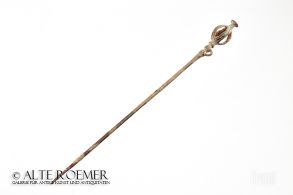 Large decorative pin from Luristan
Large decorative pin from LuristanThe pin head is shaped like an open basket with a decorative knob. Bronze with attractive patina.
Price: on request Pin from Luristan
Pin from LuristanIron Age silver pin with attractive engravings. Nice dark patina.
Price: on request Western Asiatic button seal with hares
Western Asiatic button seal with haresInteresting button shaped seal from the time of the ancient Assyrian trade settlements in Syria and Anatolia. 19th to 18th cent. BC. From the Dr. Langenkamp collection, with a scientific note from Prof. Mayer-Opificius.
Price: on request Western Asiatic button seal with scorpion
Western Asiatic button seal with scorpionInteresting button shaped seal from the time of the ancient Assyrian trade settlements in Syria and Anatolia. 19th to 18th cent. BC. From the Dr. Langenkamp collection, with a scientific note from Prof. Mayer-Opificius.
Price: on request Anatolian porphyry stamp seal
Anatolian porphyry stamp sealBasic shape of a four sided pyramid. Made of wonderful intensely red stone. Middle Bronze Age of Anatolia.
Price: on request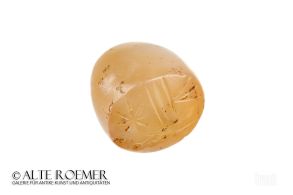 Neo-Babylonian stamp seal with religious scene
Neo-Babylonian stamp seal with religious sceneConical seal made of snowy chalcedony. The scene shows a praying man in front of an altar or symbols for the gods Ishtar and Shamash. Canonical piece for an educational collection.
Price: on request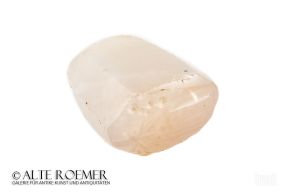 Neo-Babylonian stamp seal with religious scene
Neo-Babylonian stamp seal with religious sceneNicely facetted seal made of bright chalcedony. It shows a man in front of the gods Marduk, Nabu and Ishtar. Typical and well documented depiction from the 6th cent. BC.
Price: on request Neo-Assyrian cylinder seal with hunting scene
Neo-Assyrian cylinder seal with hunting sceneThe frit cylinder seal depicts a hunter with bow and arrow pursuing a cow. A description and dating by assyriologist Prof. Mayer-Opificius is present.
Price: on request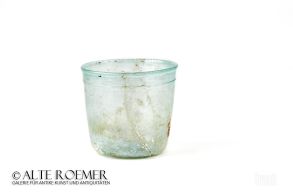 Roman glass beaker
Roman glass beakerThis beaker type was popular in the Holy Land during the time of Jesus Christ. But products of the local workshops were also exported.
Price: on request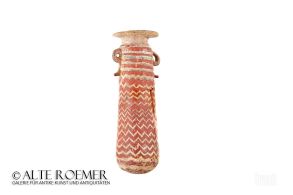 Core-formed glass alabastron
Core-formed glass alabastronColourful example from the beginning of glass manufacturing in ancient Greece. Glass vessels like this were manufactured on the island of Rhodos during the 5th century BC.
 Alabastron from colourful core-formed glass
Alabastron from colourful core-formed glassColourful example from the beginning of glass manufacturing in ancient Greece. Glass vessels like this were manufactured on the island of Rhodos during the 5th and 4th century BC.
 Core-formed glass juglet
Core-formed glass jugletThe brown glass with a decorative wave pattern imitates the shape of a Greek metal or pottery hydria, but without the handles at the sides. A nice example for the early glass production in Greek to Hellenistic times.
 Bronze statuette of Osiris
Bronze statuette of OsirisThe figurine is in exceptional condition with a nice patina. Late Dynastic period of Ancient Egypt, 664 to 332 BC.
Price: on request Roman-Egyptian portrait of a young woman
Roman-Egyptian portrait of a young womanExcellent condition, original stucco and painting partially preserved. From an old collection of a Frech engineer. With Art Loss certificate
Price: on request Serapis marble bust from Joachim Menant collection
Serapis marble bust from Joachim Menant collectionFamous egyptologist who excavated in Alexandria in the 19th century. Acquired in Egypt during this time, since then and until 2016 in the Menant family collection. With Art Loss certificate.
Price: on request Faience figurine of Isis and Horus child
Faience figurine of Isis and Horus childGoddess on a throne nursing her child Horus. Dating to the Late Period of ancient Egypt.
Price: on request Bronze statuette of nursing Isis
Bronze statuette of nursing IsisIsis is shown in a very typical depiction as a mother, the archetype of the later Christian Nursing Madonna. The bronze figurine dates to the 22nd to 31st dynasty of Ancient Egypt.
Price: on request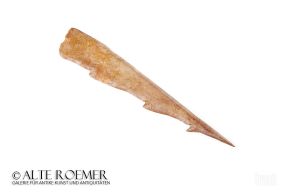 Harpoon of the Maglemosian culture
Harpoon of the Maglemosian cultureFine craftsmanship hunting weapon. Important evidence of the beginnings of fishing in Northern Europe. Mesolithic, 9000 to 6500 BC.
Price: on request

